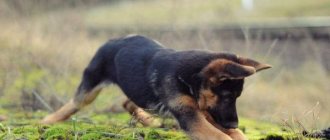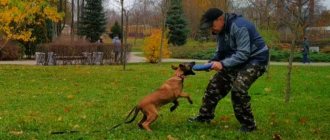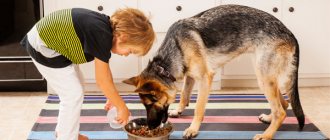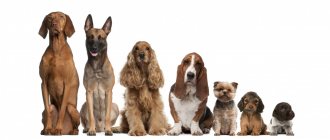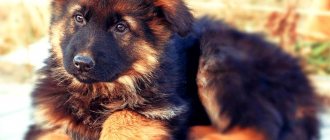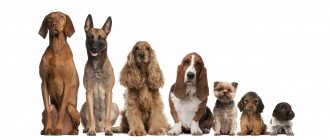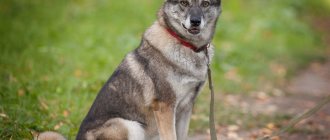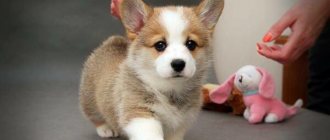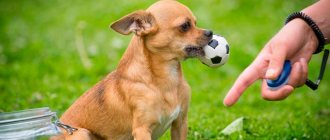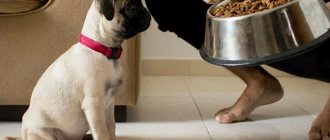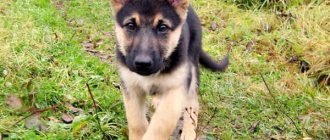The German Shepherd is a working dog. This means that her temperament, ability to acquire new knowledge, senses and constitution are focused on a single goal - serving the owner.
But the owner himself must understand that he will have to fulfill a number of requirements in order to raise an obedient and well-mannered German Shepherd. To do this, you will have to make an effort on your part, because the owner must become both a leader and a friend for the shepherd.
Otherwise, the innate positive qualities of the BUT will acquire negative properties, which will greatly complicate the cohabitation of a person and a shepherd dog in the same area, be it a city apartment or a private house.
To avoid such a situation, it is not enough to exercise a German Shepherd from time to time, feed it according to a schedule and walk it 4-6 hours a day; it must be raised correctly.
Raising a German Shepherd puppy begins from the first day of settling into its new home!
Mental and physical characteristics of the breed
“Germans” can be taught not only the basics necessary for a city dog, but also more complex techniques recommended for working breeds. They easily and willingly absorb new knowledge, so with the right approach, the result will not be long in coming.
Learning Abilities
In addition to developed intelligence, it is important to note unquestioning submission not only to one owner, but also to another person. This makes training easier for the whole family.
“Germans” are used by rescuers, law enforcement officers and customs officers. In emergency situations, animals use their skills without waiting for an order and perform their work without being distracted by stimuli.
Character Traits You Need to Know
“Germans” are people-oriented. They are attached to their owners, calm, balanced and very loyal. Thanks to these character traits, even children can cope with their learning.
Problems can only arise with puppies. In adolescence, they often show stubbornness, so they need to be taught using the play method with mandatory encouragement.
Important points in physiology
In addition to a flexible psyche, it is important to note the unique physical characteristics. Representatives of this breed are very hardy. They are able to perform their duties in the rain and snow for at least 10 hours in a row, which is very important when patrolling the territory, escorting or tracking down a criminal.
Are they easy to train?
The German Shepherd is an intelligent and quick-witted dog . She learns easily and willingly, memorizing new commands quite quickly and is ready to do everything to please her owner.
But at the same time, the temperament and, sometimes, stubbornness inherent in representatives of this breed may not have the best effect on the learning process.
Especially while the puppy is still small: he is often distracted and, if he doesn’t like something, he may refuse to follow the command.
In order for your pet to take training seriously, you need to interest him . To do this, you need to use the play method and encouragement with treats.
Read more about the personality traits of the German Shepherd here.
Basic rules of training
Most often, the duration of training a German Shepherd depends on the trainer. If an animal takes a long time to remember basic commands, then the training method used should be reconsidered.
Choosing a place and time
Based on the purpose of training and the age of the four-legged animal. At first, you can learn commands right at home, then go outside to a closed yard, and at the very end, connect background stimuli in the form of other people, dogs and vehicles.
Owner's behavior and intonation
Very often mistakes are made in behavior during training. Try not to deviate from the following recommendations:
- Give orders in a clear voice using short notations.
- Do not change previously used commands. Words and gestures should not be different. Substitution with synonyms or sudden command with the other hand is unacceptable.
- Order, don't ask. Periodic begging will ruin the whole discipline. Follow the order-execution-reward pattern and be sure to punish the dog for disobedience.
.
Another important point is intonation. Only 3 are used in training:
- an order pronounced in a stern and clear voice;
- the affection that accompanies sincere praise;
- a threat that involves the use of the most menacing and harsh intonation.
Do not deviate from the algorithm and do not give in to provocations. Over time, the dog will understand that disobedience does not bring anything good, and will stop being stubborn.
Reward, punishment, coercion
Treats, petting, and praise are used as rewards. Try to include pieces of dry food or dog biscuits in your daily diet to avoid obesity in your overly savvy pet. Gradually reduce the amount of food given out to a minimum, and then remove it altogether. In this case, verbal encouragement and affection will be more than enough.
Good-natured owners may be frightened by the need for punishment, but they cannot do without it. For disobedience, the animal should be lightly patted at the withers. A sternly pronounced “bad”, a jerk of the leash, or a sharp blow of the whip in the air will also work.
Please note that hitting the dog is strictly prohibited. Inflicting pain is fraught with retaliatory aggression or cowardice. All this will not only not bring results, but will also result in serious mental problems.
Another important training tool is coercion. It allows you to achieve trouble-free execution of orders. It is used in 2 cases:
- The puppy just recently became acquainted with a new command and is having problems remembering it.
- The dog has mastered the skill, but avoids demonstrating it.
In both cases, they are forced to perform with light pressure. For example, when practicing the “Lie Down” skill, the trainer gently but persistently presses on the withers, forcing him to take the desired position.
Basic methods
There are 6 training methods based on the way they influence a dog. These include:
- Mechanical. The incentive is an encouraging stroking or forced hand pressing at the right moment. Suitable for adult dogs.
- Game. An auxiliary method used to train puppies. It is safe for the nervous system, but gives lasting results only when combined with other methods.
- Push method. Another auxiliary method used in the early stages of training. The animal is encouraged to act using a leash or hands.
- Tasteful. Food reinforcement produces quick results, but is not suitable for all skills.
- Imitative. Used strictly in combination. They resort to it in group classes, when young dogs copy the skills of more experienced four-legged dogs.
- Contrasting. The most effective, combining food motivation techniques and mechanical stimuli.
When choosing, take into account the characteristics of your pet and your own capabilities. Remember that the most important thing is to maintain a balance between reward and punishment. Otherwise, you can raise an antisocial, aggressive and uncontrollable animal.
Motivation
Motivation can be internal and external. Rewarding with toys, food and praise is considered the second option. The effect of such motivation is the shortest, since the motivation to action is spurred on from the outside.
In the learning process, it is necessary to achieve internal motivation. This means that the dog must follow instructions without additional reinforcement, that is, of its own free will. This effect is possible when using a game form of training or introducing significance to the actions performed. According to the first scheme, they work with pets, and according to the second, with service dogs.
Training a puppy from two to four months
When the puppy has received all the necessary vaccinations and has begun to actively explore the world around him, the owner must make every effort to ensure that the acquaintance between the small dog and the street is successful. You need to walk the puppy a lot, show him as much as possible. German Shepherds have a flexible psyche, and from an early age the puppy needs to learn as many irritating factors as possible. Therefore, they walk the dog in noisy and crowded places, travel on public transport, and introduce the puppy to other (friendly) dogs.
Socialization is the most important part of raising a dog.
It is necessary to ensure that the puppy reacts equally evenly to any stimuli. The dog should not be afraid of the new or incomprehensible, but also should not be overly interested in something. To achieve this, a person must simply do his business as usual. Example: outdoor equipment is running loudly on the street. What to do? Without unnecessary excitement, guide the puppy past rumbling cars, without giving in to his fear, if any arises. The dog “reads” the owner’s mood and emotions and, when it realizes that nothing bad is happening, it simply stops perceiving the stimulus. The worst thing you can do if your dog is nervous and afraid is to reinforce its behavior (change the route, go around the obstacle, turn around and walk away). Thus, the age of up to four months is considered the period of “grinding in” between a person and a dog, a period of socialization, adaptation and setting boundaries.
The calmness of a person is always transferred to the dog
How to train a German Shepherd puppy by month
Recommendations for training a German Shepherd puppy depend on age. Up to six months, the baby’s nervous system is still developing, so it is better to conduct all activities in a playful way.
2-4 months
At this age, the baby is taught the basics: nickname, place, toilet and wearing equipment. They are introduced to the leash after all vaccinations have been completed. The distance of the route during walks is increased gradually, starting from deserted places.
During this period it is very important to build the right regime. Encourage activity during the day and discourage it at night.
4-6 months
You can master all basic skills in up to six months. Training your German Shepherd puppy during this period should be gentle. His skeleton is still forming, so overcoming projectiles is recommended to be left for a later time.
By six months, the baby should be able to perform several commands in a row, as well as know their extended versions. For example, when performing the “Sit” skill, you will need to not only take the correct position, but also remain in it until you receive a new order.
From six months and older
After six months, you can safely increase your load and sign up for additional courses. A trained German Shepherd must know not only voice commands, but also gestures. During adolescence, temporary disobedience may occur, so be patient or seek help from a dog handler.
About the command: “Lie down!”
The same principle applies to instilling endurance and training a German Shepherd to work flawlessly at a distance and with other main teams.
The only thing with the command: “Lie down!” Wait!" you will have to use 2 strict collars and 2 leashes at once, one of which is fastened to the second collar and passes under the shepherd’s belly, preventing it from standing up.
Command: “Lie down!” - one of the most difficult commands, because the lying position is a position of submission. If your German Shepherd agrees to stay in this position next to you from the age of 8 months, because... trusts you, then when you leave she will feel defenseless and try to change her position.
When starting training using this command, at first it is better to add to the training arsenal not only a treat, but also a favorite toy that you will leave next to the puppy.
Video: German Shepherd performs high five commands
Does a dog need OKD?
OKD, or general training course, is aimed at minimizing unwanted behavior and disciplining the dog. It is recommended for all four-legged animals, but is required for working breeds and participants in dog shows.
What's included in the course
Unlike UGS (“Urban Dog Management”), OKD is a more advanced course. It includes working out:
- commands “Place”, “Sit”, “Lie down”, “Stand”, “Come to me”, “Nearby”, “Fu”, “No” and “Fetch”;
- neutral reaction to scattered food, muzzle, shots and demonstration of bite;
- passing the obstacle course.
After successfully completing the course, each four-legged animal receives a certificate.
Who is suitable for group and individual lessons?
Group classes are recommended for companion dogs, and individual classes are for working breeds and dog show participants. Both options have their advantages and disadvantages.
Studying in a group makes it difficult to quickly memorize, but it helps to socialize and get used to stimuli. Classes with a trainer are more expensive, but they are aimed at perfect execution of orders for their subsequent application in everyday work - or with the goal of getting high scores in a competition.
Walking rules
If the shepherd lives in an apartment, then you need to walk with it at least 1.5-2 hours a day. You need to walk your pet in a spacious, open area, where he can run around to his heart's content, frolic, and play with a stick.
Ideal options would be:
- forest or forest belt;
- field;
- wasteland;
- big park.
If there are a lot of people around, especially children, then you need to walk the dog on a leash, even if it is very well-mannered. During play, a massive dog may not notice the child and knock him down, which in the future can cause problems for the owner of the animal.
As for walking in winter, in most cases shepherds do not need clothing - these dogs feel quite well at temperatures down to -10 degrees. But if the weather is too cold, then you can buy a jumpsuit for your pet.
How to train a German Shepherd at home
Details on how to teach a German Shepherd commands are given in the UGS and OKD courses. Despite this, success can be achieved at home by studying the whole theory on your own.
Accustoming to ammunition
Place a treat in the muzzle to keep your dog in it. Then put on the gear and praise. After a few seconds, remove the muzzle and praise your pet again. Repeat this exercise several times, increasing the time spent in the equipment until attempts to remove it disappear.
"Sit", "Lie" and "Stand"
During training, demonstrate the desired position by lightly pressing on the croup so that the dog sits or lies down. After completion, be sure to give out a treat.
Having practiced “Sit” and “Lie down”, proceed to the “Stand” order. To perform this, you need to lift the animal, tightening its stomach, and hold it in the desired position, grabbing the collar with the other hand.
“To me”, “Near” and “Walk”
These commands are needed for a German Shepherd outdoors. When saying “Come to me,” be sure to follow with the nickname and reward your pet after returning.
“Nearby” prevents distraction by irritants. While walking, keep your dog on a leash to your left. If he tries to run away from you, pull on the leash and command “Near.”
“Walk” is a positive command used for encouragement. It can be spoken at different stages of training, rewarding your pet for success with a walk without a leash.
"Ugh" and "No"
“Fu” is practiced for a strict ban, and “No” for a temporary one. The first command is used to stop picking up and attempts to attack a person, and the second is used to stop begging and suppress barking.
These commands are the most difficult for the German Shepherd, as they do not involve reward. When training, only punishment for disobedience is used. For this reason, perform no more than 5 prohibition commands in 1 lesson.
"Aport"
Your favorite toy is suitable for training. If the pet catches it, but does not bring it back, use the “Come to me” command. After that, take the toy and praise the dog. Continue doing the exercises until the pet begins to fetch the toy on its own immediately after the “Fetch” command.
"Voice"
To practice the “Voice” you will need a source of excitation. Tease your four-legged dog with food or a squeaky toy and make him bark. After this, immediately command “Voice”, praise for completion and give the demonstrated item to your pet.
Communication and socialization skills
A pet should be calm towards other people and animals. He needs to be socialized from early childhood, taking him for walks to special dog parks and busy streets. Be sure to stop any attempts to attack others to avoid aggression in adulthood.
Living skills in the city - reaction to noise, movement
When accustoming your pet to urban conditions, try to demonstrate places with different levels of noise and movement. Avoid attacks on cyclists and cars, and also teach him to cross the road when ordered “Nearby”.
Over time, the animal should get used to background sounds and traffic. They should not frighten him or distract him from training. Otherwise, it is recommended to contact a zoo psychologist or dog handler.
What to do if your pet bites?
The German Shepherd is too serious a dog to be bitten by. That is why all attempts by a puppy to bite its owners must be strictly suppressed, and the pet must be punished and sent to its place.
If a shepherd dog deliberately tries to bite its owners during play, then you can wean him off this using one of the following methods:
- Ignoring. The owner stops the game and goes into another room for about 20 minutes. All this time he does not pay attention to the dog. This way he lets the puppy know that they will play with him only if the pet does not behave aggressively.
- You can hold the dog's muzzle and hold it until the shepherd stops growling at its owner.
- Lift the puppy by the collar and shake it slightly.
- An older dog, who is already difficult to lift, needs to be grabbed by the collar and pressed to the floor, forcing him to lie down on the floor. It is necessary to hold him for some time, not allowing him to rise without permission.
A young shepherd dog should only be punished for intentional aggression . If a puppy, while playing, accidentally grabbed the owner with his teeth, then it is better to simply stop this game and switch the animal’s attention to another, more harmless one.
What should you wean your dog off of?
Training involves not only learning new skills, but also stopping unwanted behavior. This includes picking up on the street, begging and barking for no reason.
Pick up on the street
Picking up is fraught with poisoning. Weaning off this bad habit can save your pet's life. To do this, you will need to learn the word “Fu” and pronounce it every time the four-legged one tries to grab something from the ground. If you disobey, you can sharply pull the leash.
It is better to scatter food on the street yourself, so as not to practice the exercise on questionable objects. Ultimately, the dog should spit out the captured piece immediately after pronouncing the word “Fu.”
Begging for food
Give food strictly during feeding hours or as a reward. Otherwise, the dog will remember that a pitiful look, barking or whining always results in a reward. Ignore her provocations and do not feed her from the table.
During lunch, command “Place” so that your pet does not look at your plate. For any attempt to enter the kitchen, use punishment, and for obedience, any reward, including giving treats.
Bark and howl
A trained German Shepherd should not disturb others. Barking on her part is welcomed only after receiving the appropriate order. In all other cases, use “No” or “Quiet”. The method of ignoring (going to another room) and distraction (sharp clap or splashing water from a spray bottle) is also suitable.
How to stop eating anything on the street
Weaning a dog from picking up tasty, and often not very appetizing, pieces from the ground is one of the main tasks of any responsible owner, since a dog that pulls everything that is more or less edible into its mouth can easily become poisoned.
In order to stop your pet from grabbing anything on the street, you should ask an assistant to scatter pieces of meat or other food around the area of your private home. After that, take your pet on a long leash, bring him to this place and give the command “Walk!”
As soon as the shepherd reaches for the meat, you need to say “Ugh!”, and if the dog continues to try to eat the scattered food, then you need to sharply pull the leash . Repeat this every time until the dog stops trying to take the food.
After this, you need to practice the same skill, but without a leash. To punish your pet from a distance, you can use an electric collar or throw small stones at the dog.
CAREFULLY!
You cannot teach a dog to pick up food from the ground before it has been trained to track or search the area.
Common mistakes of a novice trainer
Errors in the absence of practical experience are quite understandable, but they can really be avoided after studying the theory. The most common include the following:
- Use of physical force.
- Lack of regular classes.
- Violating your own prohibitions.
- Frequent repetition of the same command.
- Neglect of punishment for disobedience.
- Move on to more complex skills before mastering easier ones.
Try to spend enough time with your pet to gain his trust and love. Remember that new knowledge is best learned when both participants are in a good mood.
Traditional food
By choosing natural products, you are choosing the right approach to your diet. Let's look in more detail at what is best to feed your baby.
As mentioned above, a third of the food should consist of protein foods. This includes meat, mostly raw, eggs, and dairy products. It is impossible to raise a good dog by feeding a puppy only cereal. In addition to protein, the diet also includes carbohydrates, fats, vitamins, fiber and minerals.
Meat must be given in raw form daily, finely chopped in advance. Giving minced meat is a bad option; if the baby eats it, the stomach will not digest it. Thanks to this meat, the pet grows healthy and strong; it is the best material for building muscles and bones. It is necessary to start feeding with meat from 50 grams to a month, in a month they already give 100 grams, in two - 200 grams, in three - 300 grams, etc. The daily norm is best divided into three to four times. The following meat options are recommended: veal, beef, horse meat. It is best to cut off fat; it can cause indigestion. No pork!
By-products begin to be given to the puppy at four months, three times a week. Although the baby eats them well, they are not a substitute for meat. The liver is given only in boiled form, in order to prevent worms from entering the dog’s body. In addition to the fact that it is easily digestible and rich in vitamins A, B2, B12, nicotinic acid, iron, zinc, copper, liver also has high dietary properties. The udder, lungs, heart, kidneys, rumen, spleen begin to produce from six months. May contain useful elements such as vitamins A, B, calcium, and minerals.
Poultry by-products such as skin and entrails have high energy value. Tubular pork and poultry bones should not be given to shepherd dogs at all - the dog may choke. In addition, sharp fragments of such bones can injure the esophagus.
Eggs are a nutritious product; it is enough to give them once a week in the amount of two pieces. Only raw yolks, which can be mixed with porridge, are eaten. Raw proteins are not digestible. They can also be served as an omelet.
Dairy products. First place will be given to cottage cheese with a high calcium content. 350 grams daily will be enough. Chilled cottage cheese is mixed with whey and served in a porridge form. Then come yogurt and kefir, which have a good effect on digestion. It is best to give your puppy unboiled goat or cow milk daily.
Fish is rich in substances such as vitamins, trace elements and minerals. Serve only boiled, without bones, twice a week. But you need to be extremely careful when giving fish to your puppy, as freshwater species can be infected with tapeworms. We recommend giving fish after a year. Squids are very useful, helping to improve the properties of wool, containing vitamins B6, PP, B12, B2.
Dairy, animal, and vegetable fats are an integral part of a pet’s diet. They are based on vitamins and fatty acids, thanks to which the baby grows healthy and immunity increases. If you have prepared lean food, be sure to add butter or fat to it. Daily norm: 2 grams per kilogram of weight. Up to three months, 10 - 15 grams will be enough, from 3 to a year of months it is necessary to give 20 - 30 grams.
Carbohydrates in some cases can replace fats, giving the puppy energy for growth and proper bowel function. They are found in sugar, plant fiber, and starch. 10 - 15 grams of carbohydrates per 1 kilogram of weight is enough.
Bread and cereals are not the main food, so they are used in small quantities. For cereals, give preference to rice, millet, buckwheat, boiling them in the form of porridge with the addition of vegetables. "Hercules" is given after six months. 250 - 300 grams is enough to give daily. Gray or rye bread is given in small portions in the form of crackers soaked in low-fat broth.
It is better not to give legumes to your shepherd; she does not eat them well.
Vegetables can be given in grated form, making salads with a small addition of vegetable oil. Boiled pumpkin with porridge is a good choice for vitamin food. Stewed vegetables are easily digested by the stomach. It is advisable to periodically give your baby tomatoes, which he eats with pleasure, especially in winter; they do an excellent job of cleaning teeth from plaque. To prevent worms, add a clove of garlic to your pet's food. But potatoes are best eaten raw.
Herbs are an excellent vitamin supplement. Of all the herbs, it is better to avoid sorrel - it causes acute gastritis.
Fruits and berries are perfect for the diet, the introduction to which must begin at an early age. But avoid grapes and citrus fruits.
Mineral nutrition should be included in the diet every day so that the baby looks good. Pharmaceutical sulfur can be given a pinch along with meat to improve the quality of wool; Seaweed has a good effect on color due to its high iodine content. Eggshells contain calcium; they must be fed in powder form from 1.5 months with 0.5 teaspoon per day, increasing the dose to one teaspoon three times a day by four months. Meat and bone meal should be added to the puppy’s soup 2 times a week. When the shepherd grows up, this flour is placed in a separate bowl next to the water so that she can eat it whenever she wants.
It is not advisable to give sweets, because they make the baby eat poorly. If you want to pamper your puppy, it’s better to give him cheese or raw potatoes.
Follow a proper diet. Be careful when caring for your pet. When introducing new complementary foods, monitor the state of the digestive system and possible allergic reactions. Snacks between main feedings are not advisable. The puppy should eat in a quiet, calm environment so that nothing distracts him from eating. This is necessary for excellent feed absorption.
Did you like this article? Leave your comments.
What else can you train your dog to do?
Among the additional training courses suitable for the German Shepherd, it is important to note ZKS, agility and mondioring.
Protective guard service
ZKS, or protective guard service, is aimed at developing social, protective and hunting instincts. This course is recommended for service breeds that have completed the OKD program.
During classes, the dog is trained to protect entrusted property, as well as to protect territory or a person. These skills are necessary to participate in search operations, escorting prisoners and searching for drugs.
Agility
Agility is a sports discipline built on teamwork. It helps you bond with your pet and keep him in good physical shape.
The classes develop speed and agility by overcoming an obstacle course. In the future, the acquired skills can be demonstrated in competitions.
Personal place
The best place for a dog in the house is a spacious enclosure, but if you decide to keep your pet in an apartment, then you need to arrange a comfortable place for him, which must meet certain parameters:
- The size of the bed should be large enough for the animal to lie on it comfortably. Pillowcases or mattresses should be removable so that they can be washed periodically;
- The bed should be located away from drafts so that the dog does not get sick;
- It is advisable to place the “bed” away from the passages so as not to disturb the dog while sleeping at home.
You can place the bed next to your own bed if such close proximity to your beloved pet does not bother you. The German Shepherd will carefully guard the owner's sleep.
